Absolutely love this amp. Much better than Tandberg already more or less in every aspect. Much preferred. Also if it was the caps - overnight they seem to have warmed up, played a little and healed themselves more or less fully. Rarely do I catch again that crashing sound that completely distorts the tweeter when heavier bass comes in, only hints of it and even that might be imagination or source material. I will replace the caps anyway once I find something suitable for the task.
I'm hearing nuances in my music I never heard before.
I'm hearing nuances in my music I never heard before.
Last edited:
Well not every aspect but definitely most. Tandberg had a little bit of an edge in warmth and the way it kind of swelled and flooded you with mids and highs. It wasn't as fast to switch, but it was intense in it's own way. Like a turbo car it would spool up and pull. It was enjoyable.
Last edited:
And I guess this NAD sounds just a little bit thin. Tandberg was thicker, had some more meat on the bones. But at this point it wasn't as clean and precise in any frequency region as the NAD. Sometimes maybe the highs had more flesh, so sounded more enjoyable. However it did have a veil and I think less clarity in the highs and overall too. Yet the, the highs, didn't sound as distant as NAD. A lot may be to blame on the recordings themselves if they have a bunch of highs that aren't really supposed to be there - Tandberg kind of hid that, but brought out the best in it instead. But I'm nit picking. This is a very good amplifier this NAD.
;-)
The NAD will become a powerful turbo;-)
One more tip regarding transistor replacement: the holes in the heat sink have minimal burrs. Be sure to deburr them. And check the mica disks for exact and minimal holes. And it's best to measure again after replacing the transistors: simply use an ohmmeter to measure the middle leg of the transistor to heat sink - should count up to infinity.
By the way: I have discovered further, other necessary construction sites on the NAD. I will let you know.
The NAD will become a powerful turbo;-)
One more tip regarding transistor replacement: the holes in the heat sink have minimal burrs. Be sure to deburr them. And check the mica disks for exact and minimal holes. And it's best to measure again after replacing the transistors: simply use an ohmmeter to measure the middle leg of the transistor to heat sink - should count up to infinity.
By the way: I have discovered further, other necessary construction sites on the NAD. I will let you know.
The negative half-wave of the output stage is also fed from two power supply units. Here too, as with the positive voltage, I have replaced the regulated one with the large power supply unit. Here the 28 volts with the 28 volts;-)
Bottom side the blue marked line. Top side the white wire arcs that sit directly on the collector connection: instead C 439, C 440. Here, too, the aim is to avoid multiple modulations due to multiple power supply units.
Bottom side the blue marked line. Top side the white wire arcs that sit directly on the collector connection: instead C 439, C 440. Here, too, the aim is to avoid multiple modulations due to multiple power supply units.
Attachments
Mouser has some of those KEMETs. Which exactly are we looking for? Also I have locally the option of Mundorf or Panasonic for the large electrolytic power supply caps. Mundorf is ~3 times pricier. Also any option on Mouser. Any recommendation? If it's not too expensive like Panasonic I'll do 20k, if pricier I'll do 10k uF. Should I also do KEMET here? What is the best available that you know of?
Attachments
Last edited:
I have purchased a few large electrolytic capacitors for power supply units, for example, but so far I haven't found any that stand out. They sometimes differ significantly, but none of them have been outstanding so far. Their different characters serve more to tune the sound. I don't know the Mundorf yet. I would be interested to hear how they sound;-)
But we also need the 2,200 microfarads for the negative feedback. I would go for the KEMET axial. These axial Kemets are among the best electrolytic capacitors I know.
https://www.mouser.de/c/passive-com...N3h8uZj8V2_MfGANXU9_ckjtCR-0KiI_ISAH-hN5NJJiT
Decades-old electrolytic capacitors can also be a real sonic surprise. But you have to shop around and test them, for example on ebay.
What also worked: several small ones. For example, 2 x 4,700 KEMET axial, then parallel and off to the bed;-)
I have just had a look at the underside: If you want to operate this NAD with source selector and potentiometer, the tape input is the one with the fewest transitions. In other words, the one with the highest sonic potential. One channel has to send the signal over a few bridges. I have removed these and bridged them with a thin wire.
And I also made the "Tone defeat" dead. It doesn't have to be there. Tone control is out of the question with a good device, because sound ("bass, mid-range, treble") comes from cleanliness, i.e. by omitting parts that degrade the sound.
And I have removed this little black three-wire jumper (switcher - poti). The material doesn't sound good. I laid two copper wires from the last selector switch (tape) to the potentiometer on the underside (white, yellow)
Regarding fuses: I have attached a secondary winding from the transformer directly to the diodes. To do this, I pulled the diodes out of the circuit board at one side and soldered the wire (red) directly. I leave the second secondary winding connected before the fuse. The fuse can then be connected in if necessary, allowing the second secondary winding to play along - for parties, for example, when you want a rumbling sound;-)
This work is should done once you have compared the sound between just one and both secondary windings. You can do this simply by removing one of the two fuses.
To ALL: Please only operate without fuses after you have used small TO-126 transistors as power transistors. These will then serve as fuses.
And to ALL: Please take personal responsibility here! I can only tell you what is the better way in terms of sound. It can also be the unsafe unfusedd one;-)
But we also need the 2,200 microfarads for the negative feedback. I would go for the KEMET axial. These axial Kemets are among the best electrolytic capacitors I know.
https://www.mouser.de/c/passive-com...N3h8uZj8V2_MfGANXU9_ckjtCR-0KiI_ISAH-hN5NJJiT
Decades-old electrolytic capacitors can also be a real sonic surprise. But you have to shop around and test them, for example on ebay.
What also worked: several small ones. For example, 2 x 4,700 KEMET axial, then parallel and off to the bed;-)
I have just had a look at the underside: If you want to operate this NAD with source selector and potentiometer, the tape input is the one with the fewest transitions. In other words, the one with the highest sonic potential. One channel has to send the signal over a few bridges. I have removed these and bridged them with a thin wire.
And I also made the "Tone defeat" dead. It doesn't have to be there. Tone control is out of the question with a good device, because sound ("bass, mid-range, treble") comes from cleanliness, i.e. by omitting parts that degrade the sound.
And I have removed this little black three-wire jumper (switcher - poti). The material doesn't sound good. I laid two copper wires from the last selector switch (tape) to the potentiometer on the underside (white, yellow)
Regarding fuses: I have attached a secondary winding from the transformer directly to the diodes. To do this, I pulled the diodes out of the circuit board at one side and soldered the wire (red) directly. I leave the second secondary winding connected before the fuse. The fuse can then be connected in if necessary, allowing the second secondary winding to play along - for parties, for example, when you want a rumbling sound;-)
This work is should done once you have compared the sound between just one and both secondary windings. You can do this simply by removing one of the two fuses.
To ALL: Please only operate without fuses after you have used small TO-126 transistors as power transistors. These will then serve as fuses.
And to ALL: Please take personal responsibility here! I can only tell you what is the better way in terms of sound. It can also be the unsafe unfusedd one;-)
Attachments
So for negative feedback we need these ones (picture attached) (but only PEG227 is in stock)
And for power supply, the biggest axial ones with appropriate voltage in stock I found from Kemet were these https://eu.mouser.com/ProductDetail/KEMET/PEG130KL4390QE4?qs=vvQtp7zwQdPKCwB0L/QQvg==
And for power supply, the biggest axial ones with appropriate voltage in stock I found from Kemet were these https://eu.mouser.com/ProductDetail/KEMET/PEG130KL4390QE4?qs=vvQtp7zwQdPKCwB0L/QQvg==
Attachments
Last edited:
Since the feedback capacitor is in series with 27 ohms, smaller ones are also sufficient. The crossover frequency with a 2,200 uF is around 2 Hertz. A 470 uF then makes 13 Hertz. And two in parallel often sound somewhat smoother.
I can't give any advice regarding the power caps at the moment. And I can't say whether these 15 mF KEMETs sound good. But we need > 30 VDC types for the NAD. Radial types are okay. I would look at the pin distance, and then > 30 VDC, capacitances > 4.700 uF. Just buy a few different ones and listen. There should be some sonic surprises;-)
I robbed my NAD of the "driver transistors". Now it only has a simple PP stage as a power amp, no "Darlingtons" longer. Now the "musicality" is higher: more flow and openness and finer colors. Simply remove these transistors and connect their base connections to the end transistors base (two white wires downside, directly from C429 and C430 to the base connections.). Simply reduce the bias. I still want to modify the bias regulation a little. But the thing works quite well as it is. I'll have to see if it remains stable with 2 x 1 volt base voltage.
But I don't want to rebuild it completely. Just so that anyone who can hold a soldering iron can do it. I want it to remain a little NAD;-)
Always take it nice and slow. Step by step. And always listen so that you get a feel for changes and sound;-)
I can't give any advice regarding the power caps at the moment. And I can't say whether these 15 mF KEMETs sound good. But we need > 30 VDC types for the NAD. Radial types are okay. I would look at the pin distance, and then > 30 VDC, capacitances > 4.700 uF. Just buy a few different ones and listen. There should be some sonic surprises;-)
I robbed my NAD of the "driver transistors". Now it only has a simple PP stage as a power amp, no "Darlingtons" longer. Now the "musicality" is higher: more flow and openness and finer colors. Simply remove these transistors and connect their base connections to the end transistors base (two white wires downside, directly from C429 and C430 to the base connections.). Simply reduce the bias. I still want to modify the bias regulation a little. But the thing works quite well as it is. I'll have to see if it remains stable with 2 x 1 volt base voltage.
But I don't want to rebuild it completely. Just so that anyone who can hold a soldering iron can do it. I want it to remain a little NAD;-)
Always take it nice and slow. Step by step. And always listen so that you get a feel for changes and sound;-)
Attachments
Last edited:
Please don't shy away from more complex modifications. This is extremely interesting even though I don't understand it all. But, just following along and soldering and listening is already a lot of fun. And if it's possible to squize more juice out of it, it's worth at least considering, who cares about the labels, sound is what matters (。•̀ᴗ-)✧
;-)
It's nice that you can also hear changes. And that you describe them in much the equal way as I do. And the comparison with your Tandberg shows that these are not illusions. It's nice that you're not one of those who deny sound and hearing, listening;-)
Let me summarize for now.
We have the big concept stories, like removing the bootstrap circuit or the soft clipping circuit or adding a capacitor that bridges the bias network. The developers and manufacturers and critics have made a real mess of things in terms of audio, sound here;-)
We have the little stories, like unnecessary small capacitors here and there that are supposed to help the high frequencies but only add de-harmonization and break in the sound, we have extra power supplies that only add more component modulation to the sound, we have unnecessarily different circuits that distort the signal.
And we have different sounding components. These too play a major role in determining the sound of a device. If you replace the transistors, for example, then...-D
And each of these stories robs the signal of definition, adding up to wishy-washiness. The NAD is a great example of this.
One of these little things is the different length connection of the two half-wave power supplies and the two half-wave amplifiers. I symmetrize these. For this purpose, 0.6 mm2 solid core is completely sufficient. We are not building a disco power amplifier;-) Simply directly from the psu caps to the output transistors. 4 identically long cables. Here (pictures) two white, two red. Here too: disconnect all the original connections so that there are no different paths.
Attention: the NAD has 1 Ohm resistor (R 455, R 456) in the plus voltages of the power transes. I let it run for the time being.
I also connected the potentiometer to the ground of the power supply with a long cable. The white cable across the circuit board. Here too: disconnect all the original connections so that there are no different paths.
And I would also advise to make a fundamental distinction: concept, such as circuit, and object, such as parts, physical build up. The experience gained from the audible qualities of the objects allows us to draw conclusions about audio-suitable and audio-unsuitable concepts;-)
It's nice that you can also hear changes. And that you describe them in much the equal way as I do. And the comparison with your Tandberg shows that these are not illusions. It's nice that you're not one of those who deny sound and hearing, listening;-)
Let me summarize for now.
We have the big concept stories, like removing the bootstrap circuit or the soft clipping circuit or adding a capacitor that bridges the bias network. The developers and manufacturers and critics have made a real mess of things in terms of audio, sound here;-)
We have the little stories, like unnecessary small capacitors here and there that are supposed to help the high frequencies but only add de-harmonization and break in the sound, we have extra power supplies that only add more component modulation to the sound, we have unnecessarily different circuits that distort the signal.
And we have different sounding components. These too play a major role in determining the sound of a device. If you replace the transistors, for example, then...-D
And each of these stories robs the signal of definition, adding up to wishy-washiness. The NAD is a great example of this.
One of these little things is the different length connection of the two half-wave power supplies and the two half-wave amplifiers. I symmetrize these. For this purpose, 0.6 mm2 solid core is completely sufficient. We are not building a disco power amplifier;-) Simply directly from the psu caps to the output transistors. 4 identically long cables. Here (pictures) two white, two red. Here too: disconnect all the original connections so that there are no different paths.
Attention: the NAD has 1 Ohm resistor (R 455, R 456) in the plus voltages of the power transes. I let it run for the time being.
I also connected the potentiometer to the ground of the power supply with a long cable. The white cable across the circuit board. Here too: disconnect all the original connections so that there are no different paths.
And I would also advise to make a fundamental distinction: concept, such as circuit, and object, such as parts, physical build up. The experience gained from the audible qualities of the objects allows us to draw conclusions about audio-suitable and audio-unsuitable concepts;-)
Attachments
I will try to analyze your descriptions together by analyzing the circuit diagram in the repair manual hopefully next week. Also although I haven't done even half of what you did to the NAD, I'm enjoying this device so much already. I feel like this is life changing stuff for me. I'm very very curious what ideas you have for the PA 940. I'm pretty sure I'm gonna be bi-amping my two way speakers (active crossover for which I still need to find a Topping DM7). Those speakers are starting to show capabilities that I didn't even expect, seem to reach much lower than before for example, but it's because there is definition instead of a big mess. The amp I like the most I am thinking of making two of and probably buying a common power supply for them, but a step at a time.
And I think I may not need class D even for bass unless like below 100Hz. To me this is more emotional and interesting and surprisingly well defined even if still a bit light (oh and bad heavy distortion at high level seems to be back on certain tracks but I think this is a technical issue with my particular unit).
I have pretty unconventional understanding in regards sound and physical energy, but without getting too metaphysical, I think even things that we can't theoretically hear can affect the way we interact with the sound. Have you ever communicated with the wind.. Have you ever recognized(remembered) your own voice as a sound as it is happening and became it.. There's telepathy just like with plants or with rocks and sound is an entity... Soo, although we aren't supposed to hear it, class D just produces a different entity due to the little wavelets of impulses and such.
You of course are very reasonable, less theory and more actual actions and improvements... most of this is wizardry to me, but the results speak for themselves. I value very much these experiments, information shared and the general approach itself - obviously it is very valuable and useful. And to me it means a lot. I wish I could contribute more, but for now I can pretty much just follow and say what I'm hearing.
And I think I may not need class D even for bass unless like below 100Hz. To me this is more emotional and interesting and surprisingly well defined even if still a bit light (oh and bad heavy distortion at high level seems to be back on certain tracks but I think this is a technical issue with my particular unit).
I have pretty unconventional understanding in regards sound and physical energy, but without getting too metaphysical, I think even things that we can't theoretically hear can affect the way we interact with the sound. Have you ever communicated with the wind.. Have you ever recognized(remembered) your own voice as a sound as it is happening and became it.. There's telepathy just like with plants or with rocks and sound is an entity... Soo, although we aren't supposed to hear it, class D just produces a different entity due to the little wavelets of impulses and such.
You of course are very reasonable, less theory and more actual actions and improvements... most of this is wizardry to me, but the results speak for themselves. I value very much these experiments, information shared and the general approach itself - obviously it is very valuable and useful. And to me it means a lot. I wish I could contribute more, but for now I can pretty much just follow and say what I'm hearing.
Last edited:
First a correction. I had removed R 431, R 432, both 1.8 kOhm, these are in parallel R 429, R 430 and thus make a second circuit. In #35 I wrote that these are in series with C 421, C 422. That is not correct. R 433 and R 434, both 47 Ohm, are in series with these capacitors and form a back coupling as an feedback circuit. I didn't read the circuit diagram correctly - it's a bit confusing. And then my perceptual misalignments took their course;-)
To ALL: Another note regarding work safety: Electrical devices have electromagnetic fields. As a rule, transformers have enormous fields. Nobody sees them, nobody hears them, but they can be felt: whether restlessness, being driven, panic loops, sleeplessness, exhaustion or even collapse and unconsciousness. Unfortunately, this is NOT taught in the current e-training courses! My advice: for adjustment work, only minimal durations, a few seconds, if possible. And for continuous operation and listening to music, keep a distance of at least 3 meters, more distance for large transformers. Also, do not place the devices next to the neighboring walls, but on the outside. Otherwise the neighbors will slip off their couch with dizziness or nausea or heart attack or stroke;-)
This is probably one of the reasons why many enthusiasts wander around here very displeased and agitated because they are sitting between their amplifiers and measuring devices and are getting the Punch;-)
The reason why the board layers on my NAD (some photos) are sometimes gone: I didn't remove the board at the beginning and pushed the soldering iron and pump under the base plate and thus worked uncleanly. In addition, these circuit boards are 30 years old or more.
I have changed a little. I have reduced the bias regulator to just the transistor and a trimmer. I connected its center leg to the base connection of the transistor. One outer leg each to the emitter and collector. And then the electrolytic capacitor emitter-collector. That's enough. I use 2 kOhm trimmers here. This way I save components and solder connections and PCB paths. This is already an exercise in assembly without a circuit board;-)
To ALL: Another note regarding work safety: Electrical devices have electromagnetic fields. As a rule, transformers have enormous fields. Nobody sees them, nobody hears them, but they can be felt: whether restlessness, being driven, panic loops, sleeplessness, exhaustion or even collapse and unconsciousness. Unfortunately, this is NOT taught in the current e-training courses! My advice: for adjustment work, only minimal durations, a few seconds, if possible. And for continuous operation and listening to music, keep a distance of at least 3 meters, more distance for large transformers. Also, do not place the devices next to the neighboring walls, but on the outside. Otherwise the neighbors will slip off their couch with dizziness or nausea or heart attack or stroke;-)
This is probably one of the reasons why many enthusiasts wander around here very displeased and agitated because they are sitting between their amplifiers and measuring devices and are getting the Punch;-)
The reason why the board layers on my NAD (some photos) are sometimes gone: I didn't remove the board at the beginning and pushed the soldering iron and pump under the base plate and thus worked uncleanly. In addition, these circuit boards are 30 years old or more.
I have changed a little. I have reduced the bias regulator to just the transistor and a trimmer. I connected its center leg to the base connection of the transistor. One outer leg each to the emitter and collector. And then the electrolytic capacitor emitter-collector. That's enough. I use 2 kOhm trimmers here. This way I save components and solder connections and PCB paths. This is already an exercise in assembly without a circuit board;-)
Attachments
The NAD is easy to open in order to access the underside of the board: Remove the front panel, loosen the poti screws, loosen the screws around the rear panel, remove the screws of the heat sinks from the base plate and then you can lift the circuit board and turn it including the heat sinks.
I have other little things that we can develop an eye for. For example, the connection of the output: also place this between the output transistors. Just make a hole near the center of the channel and solder the wire through it. The feedback will also be attached there. The C-R HF killer (C433-C435-R457 and C434-C436-R458) can stay where it is. The path via the inductor (L401, L402) is not necessary. The feedback (R429, R430) is also attached here later.
These little things add up to cleanliness and homogeneity - if ignored, to uncleanliness and inhomogeneity.
Everything just takes time and dedication;-)
I have drawn the circuit of the complete "output stage": the first three stages are a clean single ended preamp. That's all it needs. Top sound quality. You could only do better with fewer stages, but you don't need more than three stages. After Q407 and Q408, the developers could have tapped the preamp output and routed it to the rear panel.
The "output stage" is a two-stage complementary transistor push-pull. But if you try to remove the driver transistors (e.g. Q411, Q413) and listen to only one power stage, you should hear that the sound will be more musical, more fluid, more pleasing. My experience is that as soon as we make power amplifiers complex, whether as here pure 2 stages in series, or whether Darlington or Sziklai or any compound or CS, then the character of further active components adds up: it sounds more technical, more slowed down, dirtier, grayer, flatter, harder. The advantage on paper is the disadvantage in terms of sound.
An exception here are "dynamic" (signal-guided) CS,
Then I painted this pure pp output stage to show its asymmetry. I've drawn a red line as a guide to roughly separate the two half-wave amplifiers. Both half-wave amplifiers are not mirrored. This asymmetry is a sonic limit.
Anyone who has tuned the NAD up to this point should stop here and be happy!!!
I will continue here. I have drawn up some more simple half-wave balanced pp concepts. I'll probably build one with diodes first, and then replace the diodes with a resistor/trimmer. Because the best capacitors and resistors sound minimal better better than the best diodes, I'll probably end up with the second circuit;-)
Step by step;-)
I have other little things that we can develop an eye for. For example, the connection of the output: also place this between the output transistors. Just make a hole near the center of the channel and solder the wire through it. The feedback will also be attached there. The C-R HF killer (C433-C435-R457 and C434-C436-R458) can stay where it is. The path via the inductor (L401, L402) is not necessary. The feedback (R429, R430) is also attached here later.
These little things add up to cleanliness and homogeneity - if ignored, to uncleanliness and inhomogeneity.
Everything just takes time and dedication;-)
I have drawn the circuit of the complete "output stage": the first three stages are a clean single ended preamp. That's all it needs. Top sound quality. You could only do better with fewer stages, but you don't need more than three stages. After Q407 and Q408, the developers could have tapped the preamp output and routed it to the rear panel.
The "output stage" is a two-stage complementary transistor push-pull. But if you try to remove the driver transistors (e.g. Q411, Q413) and listen to only one power stage, you should hear that the sound will be more musical, more fluid, more pleasing. My experience is that as soon as we make power amplifiers complex, whether as here pure 2 stages in series, or whether Darlington or Sziklai or any compound or CS, then the character of further active components adds up: it sounds more technical, more slowed down, dirtier, grayer, flatter, harder. The advantage on paper is the disadvantage in terms of sound.
An exception here are "dynamic" (signal-guided) CS,
Then I painted this pure pp output stage to show its asymmetry. I've drawn a red line as a guide to roughly separate the two half-wave amplifiers. Both half-wave amplifiers are not mirrored. This asymmetry is a sonic limit.
Anyone who has tuned the NAD up to this point should stop here and be happy!!!
I will continue here. I have drawn up some more simple half-wave balanced pp concepts. I'll probably build one with diodes first, and then replace the diodes with a resistor/trimmer. Because the best capacitors and resistors sound minimal better better than the best diodes, I'll probably end up with the second circuit;-)
Step by step;-)
Attachments
Now a half-wave symmetrical push-pull follower is installed (see sketch above). Now I know from practical experience what the heat sink and transformer really deliver in the long term: 2 x 10 watts for the coolers and 20 watts for the transformer - because of class A. More is not possible;-) I connected the followers where NAD wanted them: "Main in").
These things, same as in Harman Citation 12 casings but with much better transes, sound very good. I played Rachmaninov's 2nd Symphony, the depth and dramatics are already very clear and distinct;-) This little thing is really satisfying and calming
I think about it, no over all feedback like in the original NAD, because the followers have their own seductive sound. They can play extra, without feedback. Both the push-pull power amps and the follower/buffer of the preamps (Q407, Q408). I'll just give it a try;-)
Regarding "metaphysics": I like to reduce the "world" to frequencies (swing) and cycles, circuits. In my opinion, the "theoretical physics" mumbo jumbo only serves to hide or conceal this. An example of frequency and cycles: almost exactly 23 years ago, 2 x 500,000 tons of building rubble disappeared at the snap of a finger;-) Our civil physicists are kept busy with nonsense. And the military and intelligence services do science that should be called "esotericism" and "meta-science" in the civilian sector;-)
Is that the reason why I love (do) audio, hifi, amps and this stuff;-?
These things, same as in Harman Citation 12 casings but with much better transes, sound very good. I played Rachmaninov's 2nd Symphony, the depth and dramatics are already very clear and distinct;-) This little thing is really satisfying and calming
I think about it, no over all feedback like in the original NAD, because the followers have their own seductive sound. They can play extra, without feedback. Both the push-pull power amps and the follower/buffer of the preamps (Q407, Q408). I'll just give it a try;-)
Regarding "metaphysics": I like to reduce the "world" to frequencies (swing) and cycles, circuits. In my opinion, the "theoretical physics" mumbo jumbo only serves to hide or conceal this. An example of frequency and cycles: almost exactly 23 years ago, 2 x 500,000 tons of building rubble disappeared at the snap of a finger;-) Our civil physicists are kept busy with nonsense. And the military and intelligence services do science that should be called "esotericism" and "meta-science" in the civilian sector;-)
Is that the reason why I love (do) audio, hifi, amps and this stuff;-?
Attachments
Last edited:
Is there a life before listening to followers;-?
It's amazing how fine and smooth and almost magical even a complementary pp follower can sound 😍
An amplifier can't even begin to keep up with that.
In the beginning it was very restrained and foggy, no low frequencies, and many would have suspected that the bases lacked current, as example, and would have started tinkering with some active current driver or something else. But with a little experience it was clear that the parts were the cause. These new trannies are among the best available, but there are still a lot of elcos and diodes, for example. I reached into the electrolytic capacitor box, installed a few of the best ones, and see, hear(-: instead of gray and flat and low-tone-less, a 3D-cut black image. Then moved the speakers 7 cm closer to the rear wall and the sound clicks in. So the original NAD psu caps also are unsuitable for audio. I'm afraid this NAD is a misconstruction throughout, whether circuitry, parts, build up, and here and there more;-)-;
I am now soldering out the nonsensical active "preamp" power supply. And the bridged preamp is also being soldered out. This will give room for a litte psu;-) I want to try out 10 or 20 cheap larger different cap types with the next order. Maybe I'll find a few suitable for audio;-)
Now I've reached the point where we can test expectations: big, black and heavy amplifier with high-gloss front against a small, light, gray, open muddle box: What sounds 3D and black and clean and what sounds flat and gray and muddle;-)
It's amazing how fine and smooth and almost magical even a complementary pp follower can sound 😍
An amplifier can't even begin to keep up with that.
In the beginning it was very restrained and foggy, no low frequencies, and many would have suspected that the bases lacked current, as example, and would have started tinkering with some active current driver or something else. But with a little experience it was clear that the parts were the cause. These new trannies are among the best available, but there are still a lot of elcos and diodes, for example. I reached into the electrolytic capacitor box, installed a few of the best ones, and see, hear(-: instead of gray and flat and low-tone-less, a 3D-cut black image. Then moved the speakers 7 cm closer to the rear wall and the sound clicks in. So the original NAD psu caps also are unsuitable for audio. I'm afraid this NAD is a misconstruction throughout, whether circuitry, parts, build up, and here and there more;-)-;
I am now soldering out the nonsensical active "preamp" power supply. And the bridged preamp is also being soldered out. This will give room for a litte psu;-) I want to try out 10 or 20 cheap larger different cap types with the next order. Maybe I'll find a few suitable for audio;-)
Now I've reached the point where we can test expectations: big, black and heavy amplifier with high-gloss front against a small, light, gray, open muddle box: What sounds 3D and black and clean and what sounds flat and gray and muddle;-)
Attachments
Hello all, pardon the relatively slow progress. I had to make some cash in the meantime to afford all of this cool stuff and some food, fuel, rent, etc. Today, although small, I made some headway. Finally got them BD441s and BD442s home and measured. Using an 8 euro Chinese device called TC1 multi-function tester. Also borrowed a really good EMF reader from a friend to test the transformer fields. And ordered PSU caps from Mouser - 22k uF KEMET. I know could be a real overkill but they will go to good use in one project or the next. Was thinking of taking some 2.7 uF coaxial KEMETs too to replace the 2.2 uF, but I'll wait till there's a clear benefit or a clear choice to replace them with. This was great fun and this week it's probably all I'm gonna be able to accomplish in regards to this project as I intend to make use of the opportunities present and make some cash. I enjoy that part of my life a lot and I'm passionate about getting back to this next week (つ✧ω✧)つ
PEH200KD5220MU2
https://eu.mouser.com/ProductDetail/80-PEH200KD5220MU2
BD442s
The BD442s seem to have relatively low variability between repeated measurements and pretty low variability between themselves too:
1. hFE 205, Ic 1.9-2.0mA, Ube 521mV
2. hFE 205, Ic 1.9mA, Ube 522-525mV
3. hFE 211, Ic 2.0mA, Ube 522-525mV
4. hFE 205-207, Ic 1.9-2.0mA, Ube 521-527mV
5. hFE 202, Ic 1.9mA, Ube 525-526mV
6. hFE 209, Ic 2.0mA, Ube 530mV
7. hFE 229-230, Ic 2.2mA, Ube 529-530mV
8. hFE 203, Ic 1.9mA, Ube 526-527mV
BD441s
hFE keeps dropping substantially with each subsequent measurement, while Ube seems to be increasing slightly. I could have kept measuring and most of them would have kept dropping in amplification hFE and increasing in voltage Ube.
1. hFE 97-101, Ic 0.78-0.81mA, Ube 529-540mV
2. hFE 99.7-100, Ic 0.8-0.81mA, Ube 536-540mV
3. hFE 97-99.2, Ic 0.8mA, Ube 537-544mV
4. hFE 97.3-97.8, Ic ~0.78mA, Ube 541mV
5. hFE 97-98.7, Ic 0.79mA, Ube 538-540mV
6. hFE 99-101, Ic 0.8-0.81mA, Ube 533-539mV
7. hFE 97-99, Ic 0.8mA, Ube 535-542mV
8. hFE 101-104, Ic 0.81-0.83mA, Ube 532-540mV
They seem relatively consistent between each other, but completely different between NPN and PNP. I can order some 20 more of each, since they're cheap. Should I do that? I shall focus on Ube matching, since hFE is so vastly different.
PEH200KD5220MU2
https://eu.mouser.com/ProductDetail/80-PEH200KD5220MU2
BD442s
The BD442s seem to have relatively low variability between repeated measurements and pretty low variability between themselves too:
1. hFE 205, Ic 1.9-2.0mA, Ube 521mV
2. hFE 205, Ic 1.9mA, Ube 522-525mV
3. hFE 211, Ic 2.0mA, Ube 522-525mV
4. hFE 205-207, Ic 1.9-2.0mA, Ube 521-527mV
5. hFE 202, Ic 1.9mA, Ube 525-526mV
6. hFE 209, Ic 2.0mA, Ube 530mV
7. hFE 229-230, Ic 2.2mA, Ube 529-530mV
8. hFE 203, Ic 1.9mA, Ube 526-527mV
BD441s
hFE keeps dropping substantially with each subsequent measurement, while Ube seems to be increasing slightly. I could have kept measuring and most of them would have kept dropping in amplification hFE and increasing in voltage Ube.
1. hFE 97-101, Ic 0.78-0.81mA, Ube 529-540mV
2. hFE 99.7-100, Ic 0.8-0.81mA, Ube 536-540mV
3. hFE 97-99.2, Ic 0.8mA, Ube 537-544mV
4. hFE 97.3-97.8, Ic ~0.78mA, Ube 541mV
5. hFE 97-98.7, Ic 0.79mA, Ube 538-540mV
6. hFE 99-101, Ic 0.8-0.81mA, Ube 533-539mV
7. hFE 97-99, Ic 0.8mA, Ube 535-542mV
8. hFE 101-104, Ic 0.81-0.83mA, Ube 532-540mV
They seem relatively consistent between each other, but completely different between NPN and PNP. I can order some 20 more of each, since they're cheap. Should I do that? I shall focus on Ube matching, since hFE is so vastly different.
Last edited:
I would buy more BD441/BD442. They sound very good and can be used in all kinds of projects. And they are very cheap;-)
You could also put together suitable pairings if you want to use fixed resistors, e.g. in a push-pull follower or amplifier. The important thing is to have the lowest DC voltage at the output. Trimmers make things easier here. The sound of complementary-push-pull concepts is impure even with the best value pairings relative to SE, for example, because the sound is essentially based on materials, cross-sections, shape and more. And experience shows that even equal parts from the same batch sound different...-)-...
I would look for PEG124. These capacitors apparently run under different labels. The values are not so relevant. I would also buy a lot of 470 uF or 2.7 mF or whatever. Audibly 2 classes above the majority of capacitors. My NAD is currently running 2 x 2 x 2.2 mF. But it would also sound great with just 2 x 2.2 mF. Compared to the sound, they are very cheap. These are worth the money.
I received 8 different new electrolytic capacitors yesterday and have listened. The small designs were all more full-bodied and focused than the original NADs, but also sounded a bit "trötig, kistig" (German) in the fundamental tone, and one was also hollow here; they all have different characters. Two big fat Nichicon caps sounded disembodied, colorless, slight distortion curtain, worse than the NAD originals. I have noted their sound characters. Later I can fall back on these as needed for tuning. There is no tip for the NAD.
I'm still waiting for two pairs of Toshibas 170/74 to finally hear them. And I also want hear more N-transistors. Then I want test P-types, also because of the preamp of the NAD - let's see if there are any good-sounding ones. As far as p-channel is concerned, I had only listened to germanium transistors (with the large germaniums, I just knock on them to know what they sound like;-), and since I practically don't listen to any complementary PP amplifiers, I didn't bother with p-channel, but settled on n-channel (higher supply). A lot of work to do now;-)
The original NAD also has a follower as power section. But it is 2-stage and half-wave asymmetrical. If you want to listen to it, without preamps (Q401-Q407; Q402-Q408), you could set the inputs to the C429/C430. I would remove these capacitors and put a capacitor in each remaining hole (pay attention to polarity), so two caps per channel, and simply connect the signal to these capacitors, e.g. the CD player or the DAC. Just try, it should run.
You could also put together suitable pairings if you want to use fixed resistors, e.g. in a push-pull follower or amplifier. The important thing is to have the lowest DC voltage at the output. Trimmers make things easier here. The sound of complementary-push-pull concepts is impure even with the best value pairings relative to SE, for example, because the sound is essentially based on materials, cross-sections, shape and more. And experience shows that even equal parts from the same batch sound different...-)-...
I would look for PEG124. These capacitors apparently run under different labels. The values are not so relevant. I would also buy a lot of 470 uF or 2.7 mF or whatever. Audibly 2 classes above the majority of capacitors. My NAD is currently running 2 x 2 x 2.2 mF. But it would also sound great with just 2 x 2.2 mF. Compared to the sound, they are very cheap. These are worth the money.
I received 8 different new electrolytic capacitors yesterday and have listened. The small designs were all more full-bodied and focused than the original NADs, but also sounded a bit "trötig, kistig" (German) in the fundamental tone, and one was also hollow here; they all have different characters. Two big fat Nichicon caps sounded disembodied, colorless, slight distortion curtain, worse than the NAD originals. I have noted their sound characters. Later I can fall back on these as needed for tuning. There is no tip for the NAD.
I'm still waiting for two pairs of Toshibas 170/74 to finally hear them. And I also want hear more N-transistors. Then I want test P-types, also because of the preamp of the NAD - let's see if there are any good-sounding ones. As far as p-channel is concerned, I had only listened to germanium transistors (with the large germaniums, I just knock on them to know what they sound like;-), and since I practically don't listen to any complementary PP amplifiers, I didn't bother with p-channel, but settled on n-channel (higher supply). A lot of work to do now;-)
The original NAD also has a follower as power section. But it is 2-stage and half-wave asymmetrical. If you want to listen to it, without preamps (Q401-Q407; Q402-Q408), you could set the inputs to the C429/C430. I would remove these capacitors and put a capacitor in each remaining hole (pay attention to polarity), so two caps per channel, and simply connect the signal to these capacitors, e.g. the CD player or the DAC. Just try, it should run.
Last edited:
- Home
- Amplifiers
- Solid State
- Modifying a NAD 302
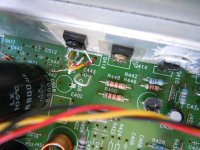
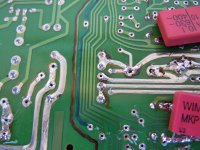
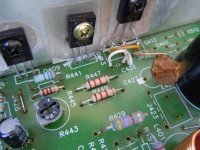
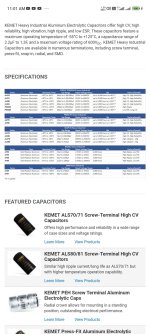
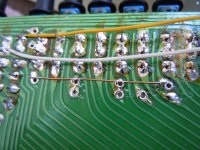
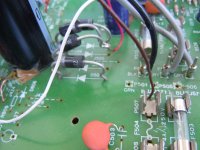
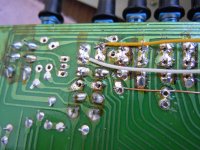
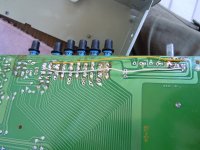
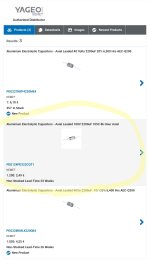
![DSCN0546[1].JPG](/community/data/attachments/1252/1252374-f2e2f350530e13540700aeef7a17d7a6.jpg?hash=8uLzUFMOE1)
![DSCN0547[1].JPG](/community/data/attachments/1252/1252375-29ce7280fcfb79a19f51ac58eff568db.jpg?hash=Kc5ygPz7ea)

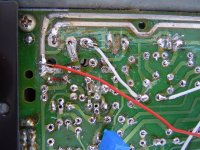
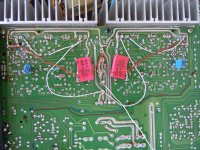
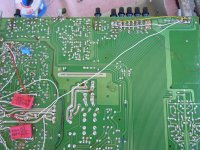
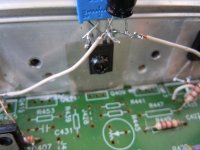
![DSCN0553[1].JPG](/community/data/attachments/1253/1253064-a56e9e3efe66ee32457665368c70f255.jpg?hash=pW6ePv5m7j)
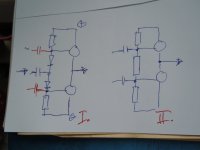
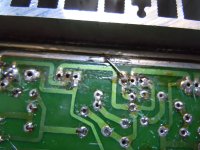
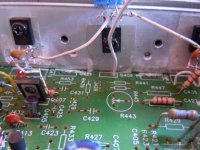
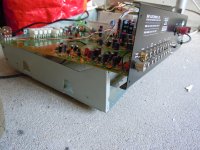
![DSCN0561[1].JPG](/community/data/attachments/1253/1253848-1005a7afeb36895ace9d2933c39656ea.jpg?hash=EAWnr-s2iV)
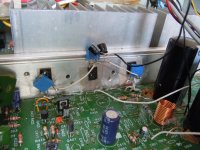
![DSCN0563[1].JPG](/community/data/attachments/1254/1254534-0119fc5da5b4b52459c2ca96f64ab73f.jpg?hash=ARn8XaW0tS)